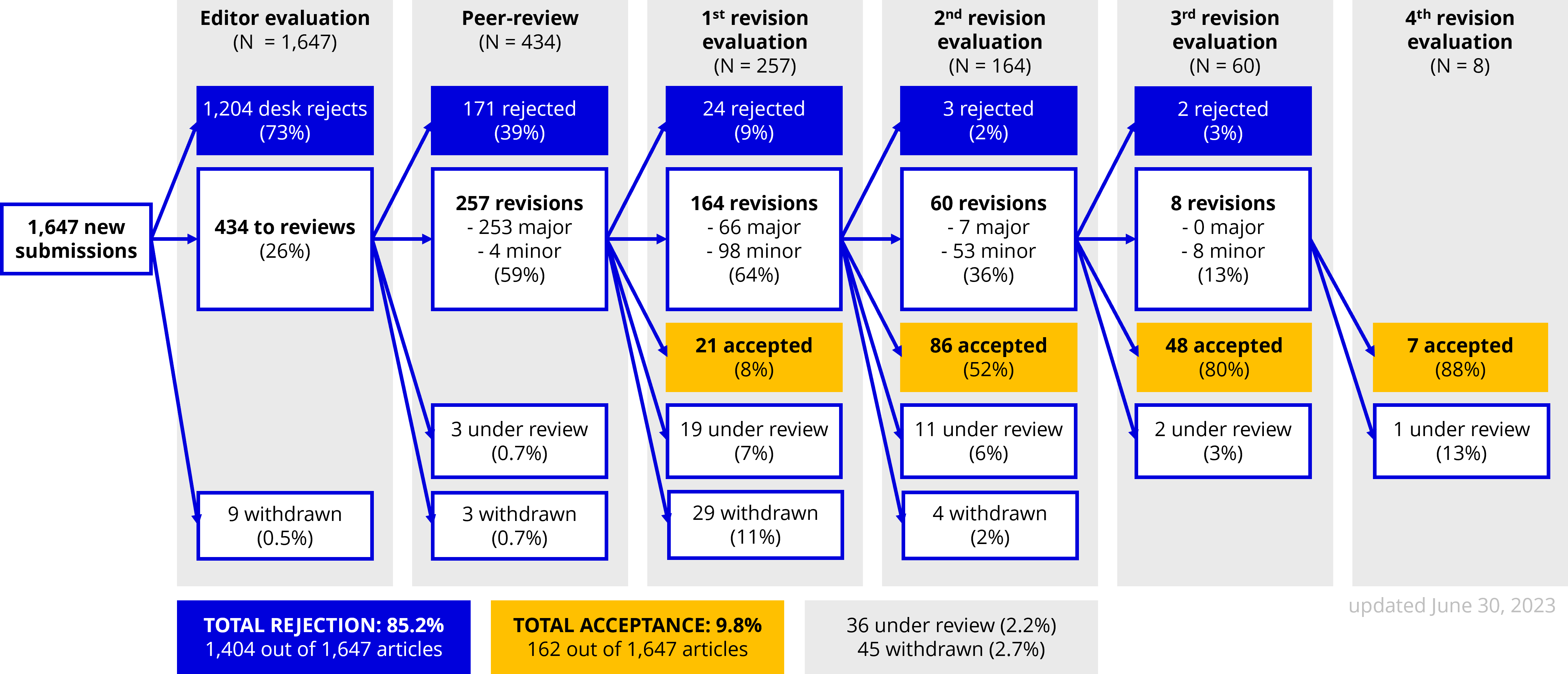Decisions and Reviews Statistics for 2022
Last year, we decided to publish our journal's submission and decision statistics. We promised to do so annually, so in this post, we share the numbers from last year, compare them with previous years, and comment on the trends in submissions, decisions, and reviews stats.
Keeping consistent with the previous report, we focus on the submissions received last year, in 2022. Because some of those submissions (particularly those sent to external reviewers) are still waiting for the final reject/accept decisions, we will also focus on a broader timeframe for some statistics.
Submission Statistics: 2022
In 2022, we received 8 percent fewer submissions than the previous year. At the same time, our desk reject rate remained almost the same, leading to fewer submissions being sent to external reviewers.
Figure 1. Submissions and Initial Decisions in 2018-2022.

Decision Statistics: 2022
After submission, manuscripts are checked internally by the journal's editors. They decide whether the manuscript will be sent to external reviewers or not. As shown in Figure 1, the desk reject rate in our journal in 2022 was 77% (all submissions from 2022 have finished the initial evaluation). This includes manuscripts rejected for being out of the scope (about one-fifth of desk-rejected articles), for detected plagiarism issues (about 4% of desk-rejected articles), and, most commonly, for reasons related to the study's quality.
About one-third of the 91 submissions sent to external reviewers in 2022 are still 'active,' i.e., they are under review or being revised and do not have a final decision yet. Hence, we will use the data from the last five years (2018-2022, N = 1,647) to show how the articles typically go through the review process (Figure 2). As simplified Table 1 shows, the overall decision rates are relatively stable, particularly from 2020 onwards.
Table 1. Decisions for Articles Submitted in 2018-2022.

In Figure 2, we can see several important aspects of the review process in Cyberpsychology. First, every article we accepted for publication these years went through at least one revision, but most went through two or three revisions. In the vast majority of cases, the first revision was a major one, typically followed by minor revision, although many articles received major revisions in the second review round too. When manuscripts are rejected after being sent to external reviewers, it happens most often after receiving the first reviews. Unfortunately, some manuscripts are rejected after a second or even third revision, although the latter is rare. Altogether, about half of the manuscripts that go to external reviewers are eventually rejected, and this number is relatively stable across the years (Table 1).
Sometimes the authors decide not to submit their revised manuscript (e.g., because the required revisions are too demanding), or they withdraw it for some other reason – in Figure 2 and Table 1, we label all such cases as withdrawn. The proportion of withdrawn cases varies across years (from 1.3% to 6.7% of all submissions in the respective year) but seems to be decreasing in time.
Finally, this leads us to accepted articles. Out of all manuscripts submitted in the respective year, slightly above one-tenth is accepted and published. This translates into approximately two-fifths of submissions that were sent to external reviewers.
Figure 2. Decisions for Articles Submitted in 2018-2022 in Each Review Round.

Decision Length
The decision length can be counted in many different ways. We have decided to present two statistics we consider most meaningful. The first is the time from submission to the initial decision (i.e., desk reject/sent to reviewers), which is the responsibility of the editor in charge of the manuscript. In 2022, this internal evaluation took, on average, 14.7 days, with a median of 10 and a mode of 4 days.
The second essential period covers the days from submission to the decision after the first review round. This is typically the most demanding period. It includes the editor's initial decision, but more importantly, searching for available and willing reviewers and waiting for their reviews. We count this only for manuscripts sent to external reviewers. Of 91 manuscripts sent to external reviewers in 2022, 3 are either waiting for reviews or for the editor to decide; hence we looked only at the 88 decided submissions. For these, receiving the decision with reviews took 128 days on average (with a median of 120 and multiple modes).
We opted not to present the decision length from submission to a final reject/accept decision. This period depends on the number of review rounds, and as you can see in Figure 2, these can go from one to four, making the average number of days from submission to final decision less interpretable.
Reviewer Statistics
Finally, we present several figures related to the review process. To make a decision, we require a minimum of two quality reviews per article. As noted above, searching for reviewers is a highly demanding task – even more recently. In order to receive enough quality reviews, we had to contact 2,060 reviewers in 2022 (unless stated otherwise, the statistics in this section are based on the first external evaluation round, i.e., they do not include the reviews of revisions). Considering the editors "only" sent 91 manuscripts to external reviewers, we needed to contact 22.6 reviewers per article – with a large variance (from four to 77, median = 19, modus = 12). This is almost twice as many as the previous year (2021).
The reviewers can decide whether they accept the invitation; out of the 2,060 review requests, about one-third (33.1%) were declined, more than half (52.4%) were ignored, and only about a sixth (14.5%) were accepted. Unfortunately, 11.7% of those who accepted the invitation never delivered their review, often without an explanation or advance notice. In all these figures, the situation in 2022 was more difficult than in the previous year – more reviewers ignore/decline review requests or, despite accepting the request, never deliver the review.
Furthermore, some reviews are unusable due to their low quality. Our editors can rate review quality from 1 (lowest) to 5 (highest); in 2022, every tenth review was rated "1" and an additional six percent as "2". Typically, such reviews do not target the manuscript's topic and fail to provide any concrete critique or advice. They tend to consist of generic proclamations that could be used for almost any text (e.g., "The Introduction needs more theory."). Moreover, they are often accompanied by unjustified requests to cite the reviewer's work. Needless to say, we do not send such reviews to the authors. Again, we noticed an unfortunate trend – in 2022, we received more low-quality reviews than before (in 2021, only five percent of reviews were rated as "1" and seven percent as "2"). The increase in ignored requests or undelivered reviews and the higher proportion of low-quality reviews make the review process more challenging for the editorial staff and prolong the time needed to obtain a quality assessment of the manuscripts.
Writing the review also takes time. About half of the reviewers delivered their reviews "on time" – within the four weeks we provided (47%). An additional quarter delivered after a reminder – within 40 days of accepting the review invitation. In reviews, we value quality over speed. We routinely provide deadline extensions, so – if you are a reviewer – do not hesitate to ask for more time if needed.
In Cyberpsychology, we contact the original reviewers for subsequent revision rounds. Only when they are not available we search for new ones. Sadly, even in this respect, 2022 was more difficult than 2021. While in 2021, 82.8% of reviewers accepted and delivered their re-evaluations, this number went down to just 58.2% for submissions in 2022 so far. However, the number might change as multiple manuscripts are still in the review process.
Concluding Remarks
You can see that the journey from a submitted manuscript to a published article can be long and complex. We are noticing a trend where finding reviewers has become more challenging and time-consuming. Unfortunately, this translates to extended evaluation periods, as we need to approach many new potential reviewers. We always aim to have at least two quality reviews from experts on the topic; therefore, it is impossible to rush the process. We are very grateful for reviewers who decide to cooperate with us, evaluate the manuscripts and provide insightful feedback. We also thank the authors for their patience throughout this process. We are doing our best, and even though it takes some time, it is always wonderful to guide/accompany the authors and articles through the whole process to a successful publication.
Lenka Dedkova, Marie Bedrošová, and Vojtěch Mýlek
